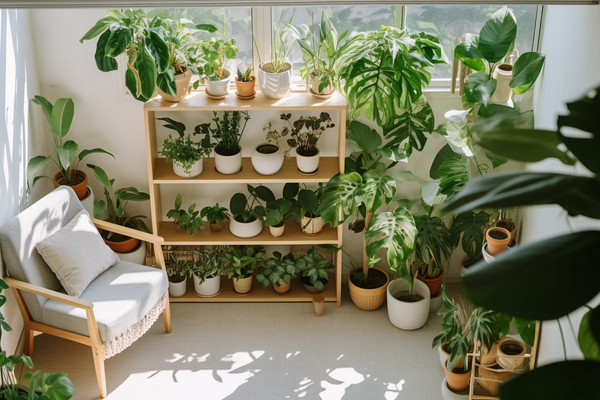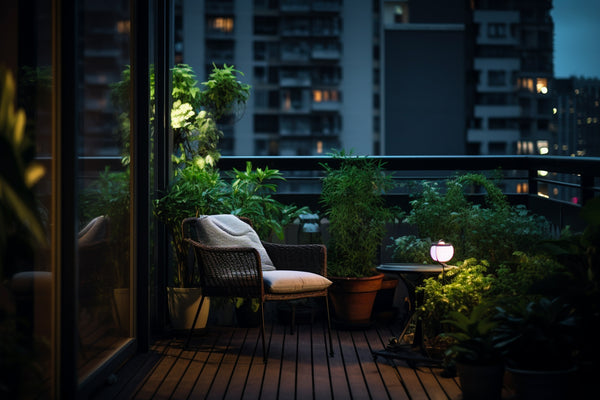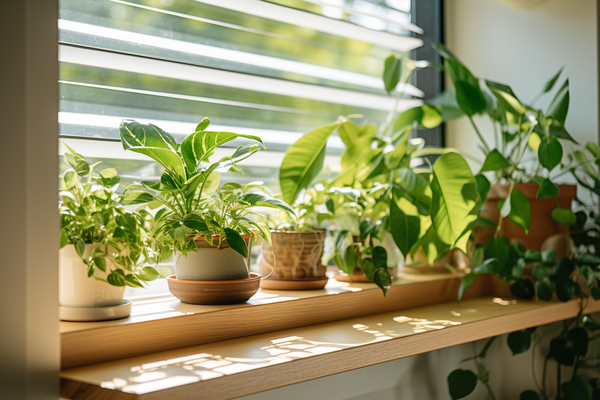Ever planned a vacation and found yourself worrying about your leafy companions back home? You're not alone. Taking care of our plants, especially when we're away, is a testament to our commitment to sustainability and the environment. After all, plants are more than just decor; they're living beings that contribute to our planet's well-being.
In this guide, we'll dive deep into ensuring your plants thrive - even when you're sipping a cocktail on a beach far away.
Understanding Your Plant's Needs

Not all plants are created equal. Just like humans, each plant species has its own set of needs and preferences. Ever noticed how a cactus thrives in the sun while your fern prefers the shade? That's nature's way of telling us that every plant has its unique requirements.
So, before you pack your bags and set that out-of-office email, take a moment to assess your plants. Do they need daily watering or can they go a few days without? Are they sun-lovers or shade-seekers? Understanding these nuances is the first step to ensuring they stay happy and healthy while you're away.
Adjusting Indoor Conditions
- Tweak light and temperature
Ensure your plants are placed in a spot with the right amount of light. Too much sunlight can make them thirsty, while too little can stunt their growth. And remember, while you might love that cozy warmth, some plants prefer it a bit cooler. Adjust your thermostat accordingly.
- The correlation between sunlight and plant thirst
Here's a fun fact: the more sunlight your plant gets, the thirstier it becomes. It's like us humans on a hot summer day. So, if you're leaving your plant in a sunny spot, ensure it has enough water to quench its thirst.
- Benefits of maintaining a consistent indoor environment
By maintaining a stable environment – be it light, temperature, or humidity – you're setting your plants up for survival. It's like giving them a comforting hug, telling them everything's going to be alright.
Efficient Watering Techniques
Watering might seem like the most straightforward part of plant care, but there's an art to it, especially when you're not around to do it daily. Let's explore some ingenious methods to ensure your plants stay hydrated while you're away.
Self-watering planters and bulbs:
- Pros:
- Hands-off approach; set it and forget it.
- Consistent water supply prevents over or under-watering.
- Cons:
- Initial setup cost.
- Might not be suitable for all plant types.
- Expert Tip: Always check the water reservoir level before leaving. Some plants might consume water faster than you think!
The bathtub method:
- How it works: Fill your bathtub with a few inches of water and lay a towel at the bottom. Place your potted plants in the tub. Use pots with drainage holes.
- Pros:
- Great for multiple plants.
- Provides consistent moisture.
- Cons:
- Not suitable for plants that dislike excess humidity.
- Occupies the bathtub, which might be inconvenient for some.
Wet newspaper trick:
- How it works: Place a piece of damp newspaper under pots with drainage holes. The plant roots will absorb the moisture as needed.
- Pros:
- Simple and cost-effective.
- Prevents soil from drying out too quickly.
- Cons:
- Might not provide enough water for very thirsty plants.
- Newspaper can get moldy in high humidity.
Globes for extra water:
- How they work: These are glass or ceramic globes filled with water and inserted into the soil. They release water slowly, ensuring plants have a steady supply.
- Pros:
- Decorative and functional.
- Ideal for plants that need consistent moisture.
- Cons:
- Need to be refilled, which might be a challenge for longer vacations.
- Fragile and can break.
- Expert Tip: Check the size of the globe's opening. Smaller openings release water more slowly, ideal for plants that prefer drier conditions.
Grouping and Positioning Plants

Positioning is everything, not just in real estate but in plant care too. Let's delve into some strategic moves to ensure your plants thrive in your absence.
Bunching plants together:
- Benefits:
- Creates a micro-environment with shared humidity.
- Reduces water evaporation, keeping the soil moist longer.
- Expert Tip: Group plants with similar water needs together. For example, tropical plants love company, while cacti might prefer some personal space.
Avoiding direct sunlight:
- Risks:
- Can cause plants to dry out quickly.
- Increases the risk of sunburn for sensitive plants.
- Alternatives:
- Use sheer curtains to filter intense sunlight.
- Relocate plants to a spot with indirect light.
- Real-life example: Carlos from Spain learned the hard way when his beloved fern got sunburned after a week in direct sunlight.
Using mulch:
- How it works: Mulch your indoor plants with layers of heavily watered peat moss. This acts as an insulating layer, reducing water evaporation.
- Benefits:
- Keeps soil consistently moist.
- Reduces the frequency of watering.
- Cons:
- Can attract pests if not monitored.
- Might retain too much moisture for plants that prefer dry conditions.
- Expert Tip: Always check for mold or pests under the mulch layer. A thin layer is often enough for most indoor plants.
DIY Tricks for Extended Vacations

Vacations are a time to relax, but if you're a plant parent, the thought of leaving your green buddies behind can be stressful. Fear not! Here are some DIY tricks to ensure your plants stay hydrated and happy, even if you're away for an extended period.
The cotton rag or rope method:
- How it works: Place one end of a cotton rag or rope in a glass or bowl filled with water. The other end goes into the plant's soil. The plant will draw water through the rag or rope as needed.
- Pros:
- Simple and cost-effective.
- Provides a steady supply of water.
- Cons:
- The water source might run out for very thirsty plants.
- Ensure the rag or rope remains damp throughout.
- Expert Tip: Use a thicker rope for larger plants as they tend to consume more water.
Pebble tray method:
- How it works: Fill a tray with pebbles and add water until it's just below the top of the pebbles. Place your plant pot on top. As the water evaporates, it increases humidity around the plant.
- Advantages:
- Boosts humidity, great for tropical plants.
- Reduces the frequency of watering.
- Prevents waterlogged soil.
- Expert Tip: Refill the tray before leaving and ensure the pot doesn't sit in the water, which can lead to root rot.
Benefits of using damp newspaper underneath pots:
- Why it works: The damp newspaper provides a moisture source that the plant can draw from.
- Pros:
- Easy to set up.
- Suitable for most indoor plants.
- Cons:
- The newspaper can dry out quickly in hot conditions.
- Potential for mold growth in high humidity.
- Real-life example: Lisa from New York swears by this method for her collection of orchids, especially during her summer getaways.
Pre-Vacation Plant Care

Before you embark on your adventure, there's some prep work to do. Think of it as setting the stage for your plants to thrive in your absence.
Giving plants a generous watering:
- Why it's essential: Ensures the soil is moist, reducing the need for additional water sources.
- Expert Tip: Water early in the day so excess moisture can evaporate before nightfall.
The importance of forgoing fertilizers:
- Rationale: Plants use nutrients more slowly when you're not there to care for them. Over-fertilizing can harm them.
- Pros:
- Reduces the risk of nutrient burn.
- Plants grow at a steady, natural pace.
- Cons:
- Might not be suitable for plants in their growth phase.
- Expert Tip: If you must fertilize, do so a week before leaving to allow plants to adjust.
Light pruning:
- Why it's essential: Removes dead or dying parts, allowing the plant to focus its energy on healthy growth.
- How to do it right: Use sharp, clean scissors or pruning shears. Cut at an angle, just above a leaf node.
- Expert Tip: Don't prune more than 1/3 of the plant at once. It can stress the plant.
Conclusion
And there we have it! Taking care of our plants, especially when we're away, is more than just a chore—it's a commitment to sustainability and the environment. These green buddies do so much for us, from purifying the air to lifting our spirits.
So, the next time you're planning a vacation, remember these tips to ensure your plants stay as vibrant and lively as the memories you'll make. And hey, if you've got some plant care tips of your own, we'd love to hear them. After all, we're all in this green journey together!
References
Swansons Nursery. 2021, August 5). 6 Tips to Help Your Plants Survive Your Vacation. https://www.swansonsnursery.com/blog/tips-to-help-your-plants-survive-your-vacation
The Sill. (n.d.). How To Keep Your Plants Alive While On Vacation. https://www.thesill.com/blog/how-to-keep-your-houseplants-alive-while-youre-on-vacation
CNET. (2022, December 18). Traveling Soon? Make Sure to Keep Your Plants Alive While on Vacation. https://www.cnet.com/home/kitchen-and-household/traveling-soon-make-sure-to-keep-your-plants-alive-while-on-vacation/
From Waste to Resource
Our efforts and commitment to waste reduction and sustainability begin with our production process.
Plastic and agriculture wastes are repurposed and utilized through innovative transformation into a biodegradable composite material.

